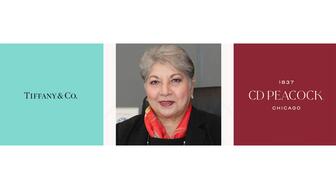The special-edition egg pendant ingested in a New Zealand jewelry store was recovered after a six-day wait.
Global luxury market surpasses trillion-dollar mark
A Bain & Company report shows that the global luxury industry has surpassed $1 trillion in retail sales value this year, with the category that includes jewelry and watches seeing slight but positive real growth.
Milan, Italy--The global luxury industry has surpassed $1 trillion in retail sales value this year, with the category that includes jewelry and watches seeing slight but positive real growth.
According to Bain & Company’s Luxury Goods Worldwide Market Monitor report released last week, the $1.120 trillion spent in luxury markets around the globe is a 5 percent year-over-year increase at constant exchange rates.
Spending in the personal luxury goods category--the category that includes jewelry and watches—has reached $253 billion, a 13 percent increase overall but only a 1 to 2 percent improvement at constant exchange rates.
In the report, Bain & Company identified three macro-economic events that hampered growth potential for the global luxury industry this year: the strength of the U.S. dollar, dissuading tourists from visiting the United States and driving Americans to buy their goods in Europe; the Chinese stock crisis impacting consumer confidence in the U.S.; and oil’s price drop reducing the wealth of most exposed economies and its key luxury consumers.
Around the world
In 2015, the strength of the U.S. dollar has continued to weaken luxury consumption in the Americas.
Department stores have suffered because of a slowdown in spending by both tourists and locals and played on promotions to bring in consumers. The off-price channel has become a top performer, with organized trips driving tourists to premium outlet centers and local shoppers looking for bargains while buying online, the report stated.
Canada also has witnessed improved luxury goods sales, as there has been decreased competition from the U.S. due to the strength of the dollar.
When it comes to cities, the report showed that the top luxury goods market in the world are New York, followed by Tokyo, Beijing, Milan, and Paris.
E-commerce
Online also has turned out to be a winner in 2015, as European and American retailers continued to actively respond to customer requests for an omnichannel experience.
Social e-commerce also has begun to pick up steam, the report said, with “buy” buttons transforming the role of social networks from pure referral to a retailer’s website to direct shopping on social platforms.
RELATED CONTENT: More social networks enter e-commerce
Mobile commerce also is becoming a central touchpoint and growing channel, with wearables potentially becoming the “new frontier of mobile,” Bain & Company said.
Off-price shopping
The U.S., Europe and Japan have been trending as the most-penetrated geographies when
RELATED CONTENT: Macy’s gets into the off-price business
The report said luxury brands currently are reconsidering their strategic approach to the off-price channel, with some reducing markdowns in regular stores and instead shuttling slow-moving merchandise to outlet stores.
Jewelry and watches
Bain & Company said hard luxury accessories, which includes jewelry and watches, have had a trend of “polarized performance” in the past two years.
Global watch sales in 2015 have dropped by 6 percent year-over-year at constant exchange rates, impacted by the slowdown of the Asian economies, a trend occurring since 2013 that also has led to the worst Swiss export figures since 2009.
Global jewelry sales, meanwhile, have risen 6 percent at constant exchange rates, with the report stating that this category is evermore perceived as a safe investment in an uncertain economic and financial environment.
Though growing at a “slower” pace, luxury branded jewelry continues to outperform the overall luxury market, as jewelry remains among the top preferred investments thanks to the intrinsic value of the raw materials. What’s more, Bain & Company said global demand for diamonds still is growing, just at a more modest pace.
Additional takeaways from the report include:
--The personal luxury goods market still is a western one, but is being driven by masses of “borderless” consumers, consumers who travel everywhere and spend anywhere;
--Consumers from mature markets are more demanding and detached;
--Retail and mono-brand stores still are the favorite formats in which to invest;
--E-commerce is starting to become disruptive, yet brands still are struggling with it; and
--Growing value awareness and blurred pricing strategies are questioning the luxury value proposition.
“For the last several years, we’ve referenced ‘luxury’s new normal’ with a deceleration of the personal luxury goods market,” said Claudio D’Arpizio, a Bain & Company partner in Milan and lead author of the study. “Now, we are starting to feel the impact of that slowdown. The challenge for luxury brands in this environment is how to successfully navigate through hard-to-predict volatility.”
The complete Luxury Goods Worldwide Market Monitor report can be found here.
The Latest

Associate Editor Natalie Francisco plays favorites with Piece of the Week, selecting a standout piece of jewelry from each month of 2025.

The “Love and Desire” campaign is inspired by the magic that follows when one’s heart leads the way, said the brand.

How Jewelers of America’s 20 Under 40 are leading to ensure a brighter future for the jewelry industry.

Two awardees will receive free tuition for an educational course at the Swiss lab, with flights and lodging included.


Sotheby’s held its first two jewelry sales at the Breuer building last week, and they totaled nearly $44 million.

Winners will receive free registration and lodging for its fourth annual event in Detroit.

Roseco’s 704-page catalog showcases new lab-grown diamonds, findings, tools & more—available in print or interactive digital editions.

Here are six ideas for making more engaging content for Instagram Reels and TikTok, courtesy of Duvall O’Steen and Jen Cullen Williams.

The honorees include a notable jewelry brand, an industry veteran, and an independent retailer.

Carlos Jose Hernandez and Joshua Zuazo were sentenced to life without the possibility of parole in the 2024 murder of Hussein “Sam” Murray.

Yood will serve alongside Eduard Stefanescu, the sustainability manager for C.Hafner, a precious metals refiner in Germany.

The New Orleans jeweler is also hosting pop-up jewelry boutiques in New York City and Dallas.

Set in a Tiffany & Co. necklace, it sold for $4.2 million, the highest price and price per carat paid for a Paraíba tourmaline at auction.

Take luxury gifting to new heights this holiday season with the jeweler’s showstopping 12-carat sphene ring.

This year's theme is “Unveiling the Depths of the Ocean.”

In its annual report, Pinterest noted an increase in searches for brooches, heirloom jewelry, and ‘80s luxury.

Starting Jan. 1, customers can request the service for opal, peridot, and demantoid garnet.

The 111-year-old retailer celebrated the opening of its new location in Salem, New Hampshire, which is its third store in the state.

The new catalog features its most popular chains as well as new styles.

The filmmaker’s personal F.P. Journe “FFC” prototype was the star of Phillips’ recent record-setting watch auction in New York.

The new location in the Design District pays homage to Miami’s Art Deco heritage and its connection to the ocean.

Inflations, tariffs, and politics—including the government shutdown—were among consumers’ top concerns last month.

“Longtime favorite” presenters, as well as first-time speakers, will lead talks and workshops at the annual event in Tucson next year.

Silas Smith of Meridian Metalworks won the challenge with his pendant that blends Australian and American landscapes.

The sale of the 31.68-carat, sunset-hued stone was part of Sotheby’s first series of events and auctions in Abu Dhabi.

Most customers who walk into your store this month have made up their minds. Your job is to validate their choice, Emmanuel Raheb writes.


























